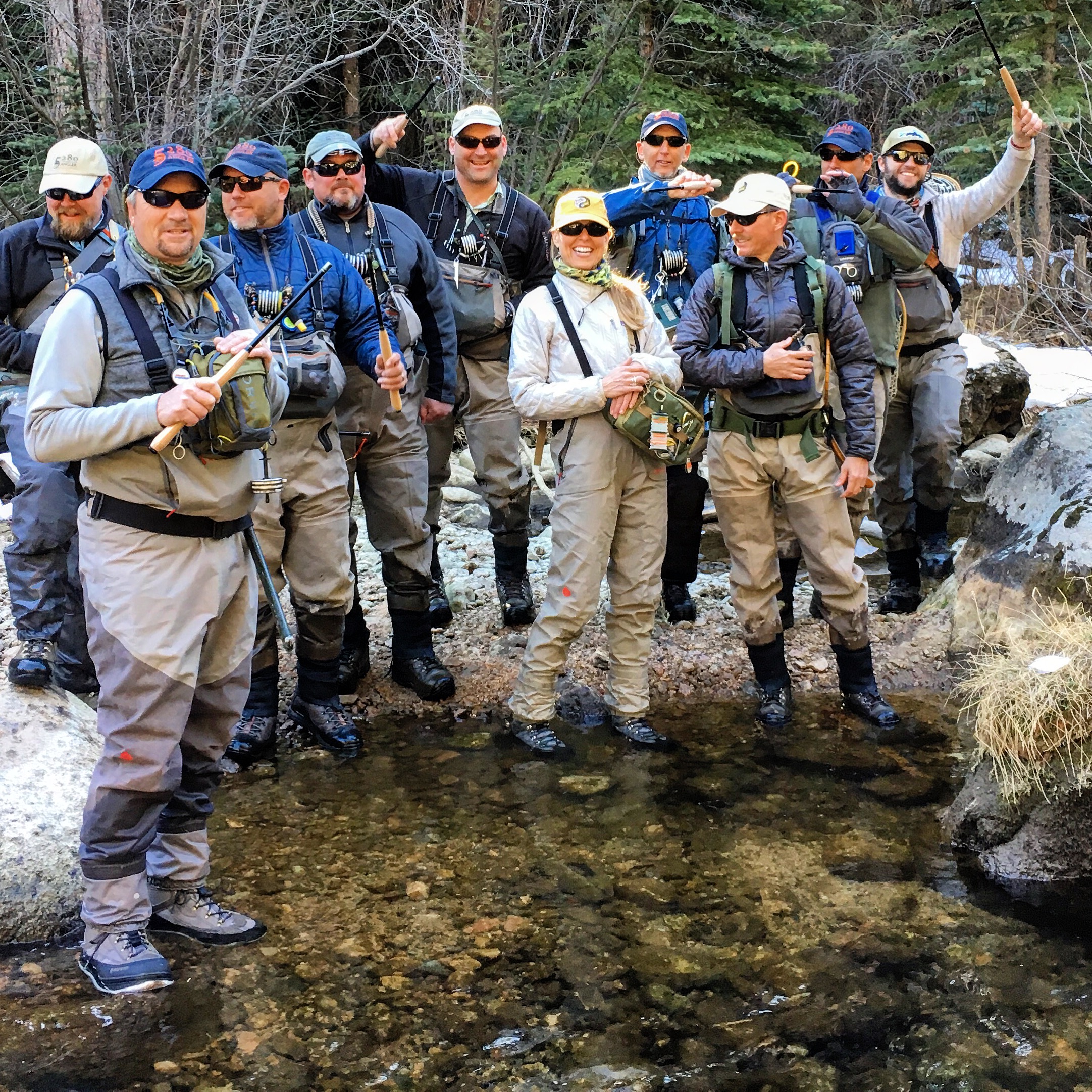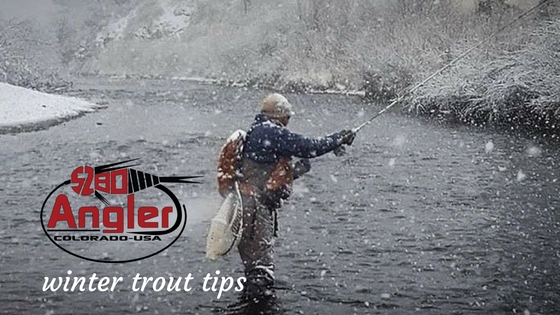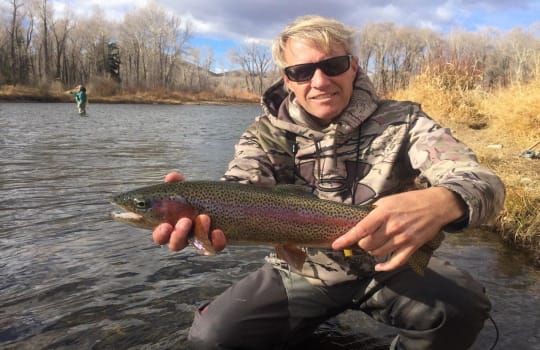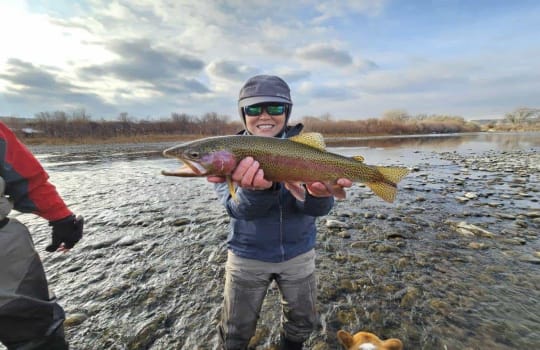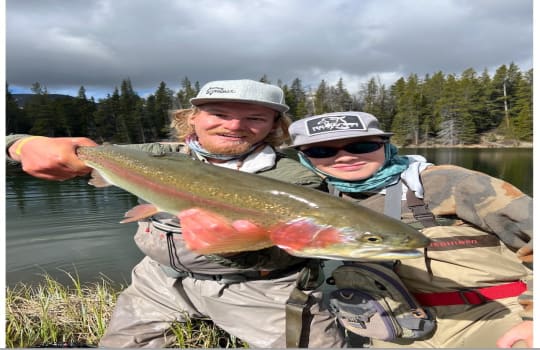FLY FISH COLORADO IN WINTER – Cold Weather Trout Tactics
Fly Fishing in Colorado’s Secret Season – How to Catch Trout in the Winter!
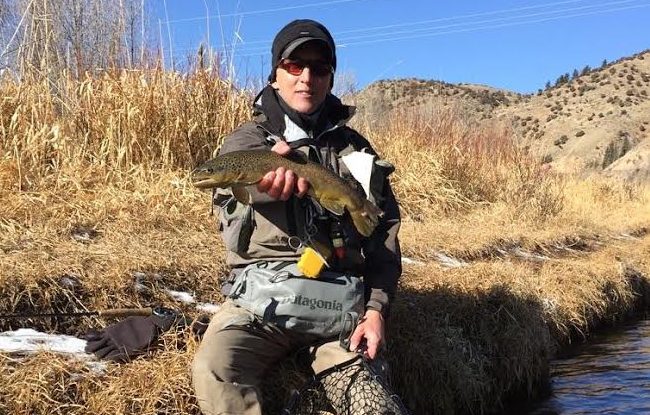
by Tom Caprio, 5280 Angler ® Professional Guide
The notion of winter fly fishing in Colorado might conjure up visions of freezing temperatures, iced-over water, ominous weather, and general misery. However, as a huge fan of the secret season, I picture something entirely different: open (both as in ice-free and crowd-free) water, quiet and peaceful rivers, beautiful trout, blue skies, late starts, and the perfect cure for cabin fever. Though winter fly fishing might not be for everyone, it’s perfect for an adventurous angler willing to wear a few extra layers. Besides, Colorado’s weather can be wacky! Keep an eye on the forecast, and you can find a bluebird, dead calm, 50 degree day in January on which to have the river all to yourself.
Ditch those lift lines for a day, cast a fly line, and you too might be a winter fly fishing convert!
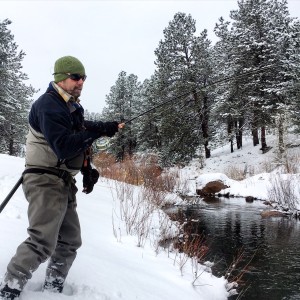
STAY WARM OUT THERE – How to Fight the Cold and Forget the Forecast:
- Dress in layers – Wear multiple wool or synthetic layers on bottom and top. Trapped air between each layer offers important insulation. Never wear cotton, which gets wet and stays wet (“Cotton kills”). Be sure to have a warm hat, buff, and fishing gloves. Hooded waterproof jackets are the best choice for an exterior layer. Bring extras of everything in the unfortunate event you fall in.
- Remember the snacks – Snacking warms up the core by engaging stomach muscles. What a great excuse for more chocolate chip cookies!
- Fill a thermos – Hot chocolate or coffee are a welcome bit of warmth along a cold river.
- Use chemical hand warmers – Place them on top of your hand inside your gloves, and body warmers (be careful not to get them wet – they’ll quit working).
- Bring a small towel – Drying your hands immediately after getting them wet is key to keeping them warm! Be sure to take off gloves before putting your hands in the water, then towel them off and slip your dry hands back into dry gloves. Keep your towel handy in a front wader pouch – away from your skin and anything else you don’t want to get wet.
- Rig rods at home – Bring one rod setup with nymphs, and another for dry fly fishing. Rig up the night before in your warm garage. I love my rod vault in the winter! See below for some winter fly recommendations, or check with the fly shop ahead of time. Cold fingers get colder tying knots with small flies and fine tippet.
- Take a break – If your feet get cold, get out of the water quickly. Move around to warm up, grab some of that coffee from the thermos, and then get back at it! Bonus: Most tailwaters offer nearby parking – if needed, crank the heater for a few minutes to avoid a day killing chill.
- Avoid guide ice – Apply paste to help prevent the line guides on your rod from icing up (lip balm or floatant will also work). Another ninja alternative here is to fish tenkara – there are no guides or reels to ice up, and the extra length and delicate presentation of tenkara offer some cold weather tactical advantages.
TACTICAL TIPS FOR WINTER ON THE FLY – How to Find and Catch more Winter Trout
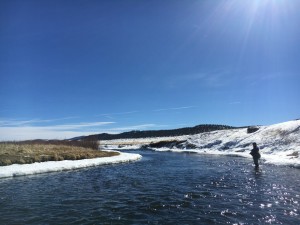
When & How to Find the Fish:
Plan to arrive mid to late morning. Look for sunlit areas where water warms more quickly. Even a couple degrees increase in water temps will trigger hatches, which will encourage fish to feed. Within those sunny areas, fish will often hold in the slower /deeper slots to conserve energy. Their metabolism slows down when water temps are cold, and so trout will feed less aggressively in the winter. But they still need to eat, so there will be enough active fish on most days to find angling success. Some sporty trout will even move into somewhat faster water to feed (or possibly higher in the water column).
Important word to the hook-setting-wise: Fish will eat your flies using absolute minimal energy, so set the hook on the slightest pause or hesitation of your indicator. The ability to detect and react timely to nearly imperceptible strikes is often the difference maker on a winter’s day.

Fly Selection & Rigging for Winter Fly Fishing Success:
When water temps are below 40 degrees, the hatch du juor will be midges (size 20 and smaller). My favorite winter midge flavors are red (thread midges, blood midges, discos, rojos), black (black beauties, zebras, jujus) cream (miracle midges, mercury midges, buckskins) and small varieties of rs2 emergers. To pinpoint the midge color/size, seine the water, or look in eddies or foam along the bank, which are collection points for hatching insects.
Use an attractor pattern in front of the midge such as an egg, stonefly nymph, scud, or San Juan worm. Use smaller tippet sizes – 5x to your attractor fly, followed by 6x to the midge – to increase your chances of hookups in low and clear winter water. It’s also very important to get your flies down to the fish (typically located along the bottom where there is less current), so be sure to add enough weight to your rig and/or raise your indicator. Keep adjusting based upon varying water depths to keep your flies in the ‘zone.’
Some lower elevation fisheries such as the Arkansas River near Pueblo will have blue winged olive mayfly hatches all winter. Still other local waters support larger midge hatches and small dark stoneflies midwinter. Consult the fly shop nearest the water you’re fishing to get a menu of likely patterns. Then use a thermometer to take the water temperature in order to narrow down fly selection one step further (BWO mayflies will hatch at 42-45 degrees).
Though winter may not be thought of as prime time for dry fly fishing, trout will occasionally rise to small midges and mayflies. A simple parachute adams (size 20-24) is an excellent option for those moments. Secret Tip: If you need a smaller profile to match the hatch, simply cut off the tail of the fly. Other midge imitations such as a Griffith’s Gnat will also work.
WHERE TO FISH – Great Cold Weather Colorado Fly Fishing Destinations

Ideal winter destinations are primarily river sections located directly downstream from bottom release dams (tailwaters). The water coming through the dam is typically warm enough to maintain open water upwards of 3-4 miles downstream. Such local destinations include:
- The South Platte River: Deckers, Elevenmile Canyon, and The Dream Stream
- The Blue River below Dillon Reservoir
- The Williams Fork and The Colorado River near Parshall
- The Frying Pan below Reudi Reservoir
- The Taylor River below Taylor Reservoir
Other options at lower elevation include the Arkansas River below Pueblo Reservoir, The Big Thompson below Lake Estes, The Gunnison River near Hotchkiss around Pleasure Park, The Colorado River below Glenwood, and the Uncompahgre River below Ridgway Reservoir.
Yet another FANTASTIC option is to treat yourself to one of the finest fisheries in the West, located right in Denver’s backyard: The North Fork of the South Platte at BOXWOOD GULCH RANCH. As long as the Roberts Tunnel remains open, Boxwood Gulch Ranch will be open this winter! Boxwood is legendary for being home to some of the largest trout in Colorado. The patio fireplace and heated clubhouse are a welcome winter fishing retreat as well!

Wishing everyone a happy holiday season, and a fishy secret season!
IF YOU’RE INTERESTED IN A WINTER FLY FISHING TRIP, CONTACT US TODAY!
